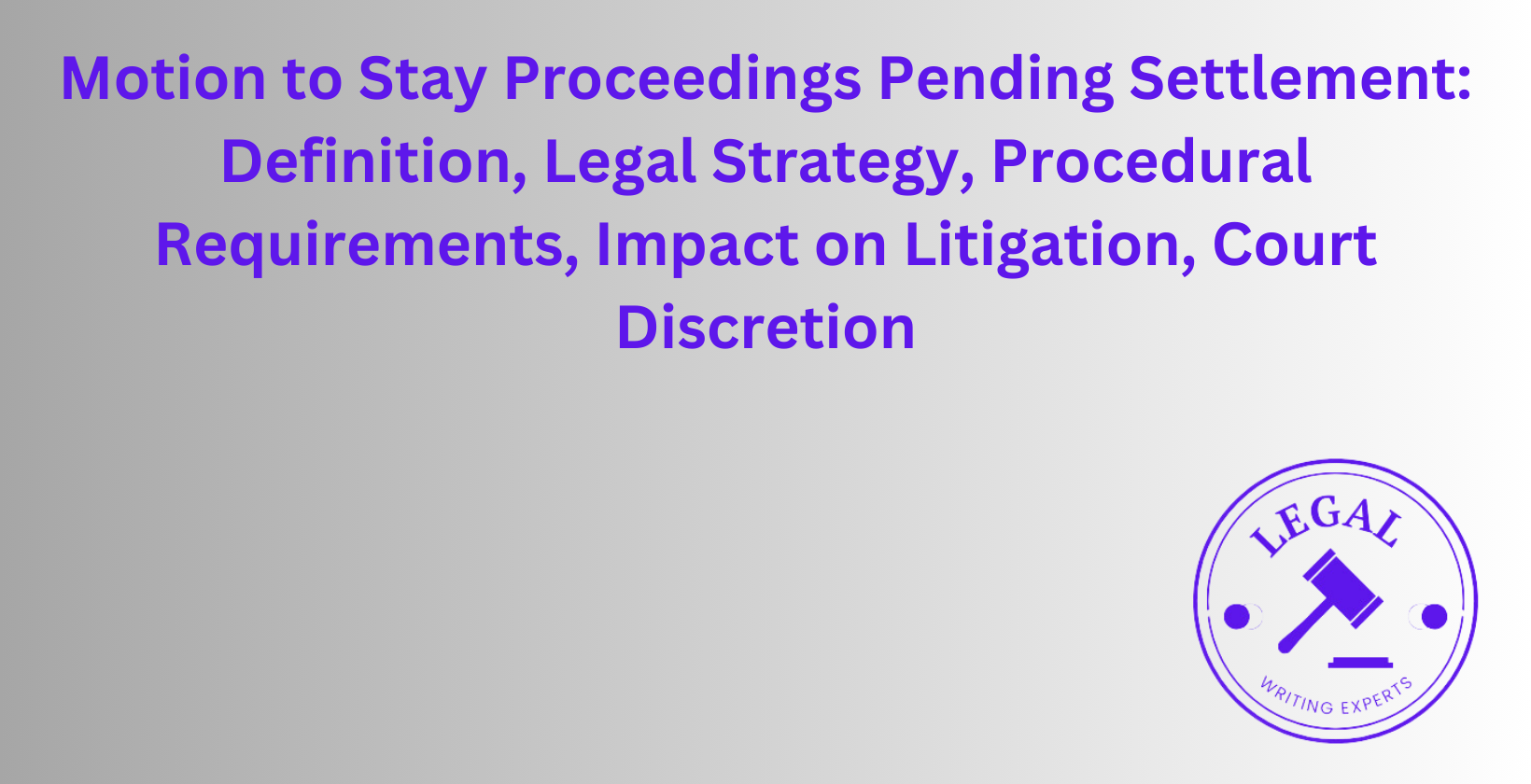Motion to Stay Proceedings Pending Settlement
Written by
Jessica E
October 7, 2024 · 8 min read

A motion to stay proceedings pending settlement is a legal request made to the court to temporarily halt litigation while parties attempt to reach an out-of-court agreement. This strategic legal maneuver can significantly impact the course of a case, potentially saving time and resources for all involved. Understanding the definition, legal strategies, procedural requirements, and court considerations surrounding such motions is crucial for legal professionals and litigants alike. This article explores the key aspects of motions to stay proceedings pending settlement, including how to draft and file them, their impact on litigation, and factors courts consider when ruling on these requests.
What Is a Motion to Stay Proceedings Pending Settlement?
A motion to stay proceedings pending settlement is a formal request submitted to the court asking to pause ongoing legal proceedings while the parties engage in settlement negotiations. This legal document allows litigants to temporarily suspend court activities, giving them time to explore potential resolutions outside the courtroom. The primary purpose of such a motion is to facilitate settlement discussions without the pressure of impending court deadlines or the risk of adverse rulings that could impact negotiations.
How to Write a Motion to Stay Proceedings Pending Settlement?
Writing a motion to stay proceedings pending settlement requires careful attention to detail and adherence to legal writing standards. The motion should clearly state the reasons for requesting the stay, including the status of settlement negotiations and the potential benefits of pausing proceedings. It’s crucial to include relevant case law supporting the request and address any potential objections from opposing counsel. The document should be concise, well-organized, and persuasive, highlighting the efficiency and cost-saving benefits of granting the stay.
Where to Hire a Legal Writer to Draft a Motion to Stay Proceedings?
Legal writers specializing in drafting motions can be found through Legal Writing Experts channel. Legal Writing Experts often have in-house legal writers or may outsource to freelance legal professionals. Legal Writing Experts is an online platform with legal writers that have expertise in motion drafting. We offer specialized assistance in creating these documents. When hiring a legal writer, it’s important to verify their credentials, experience with similar motions, and familiarity with the relevant jurisdiction’s rules and procedures.
How to File a Motion to Stay Proceedings Pending Settlement?
Filing a motion to stay proceedings pending settlement involves several steps. First, the motion must be drafted according to local court rules and formatting requirements. Once completed, it should be filed with the court clerk, often accompanied by a filing fee. Many jurisdictions now allow electronic filing, streamlining the process. After filing, the motion must be served on all parties involved in the litigation, typically within a specified timeframe. It’s crucial to follow the court’s specific procedures for filing and service to ensure the motion is properly submitted and considered.
What Are the Legal Strategies Behind Filing a Motion to Stay Proceedings?
The legal strategies behind filing a motion to stay proceedings pending settlement are multifaceted. One primary strategy is to create a more conducive environment for negotiations by removing the immediate pressures of litigation. This can allow parties to focus on reaching an agreement without the distraction of ongoing court proceedings. Another strategy is to demonstrate good faith to the court and opposing parties by showing a willingness to explore settlement options. Additionally, a stay can provide time to gather additional information or evidence that may strengthen a party’s position in negotiations or future litigation if settlement efforts fail.
What Are the Procedural Requirements for a Motion to Stay Proceedings?
Procedural requirements for a motion to stay proceedings vary by jurisdiction but generally include specific formatting guidelines, filing deadlines, and service requirements. The motion typically must state the legal basis for the request, supported by relevant case law or statutes. Many courts require a memorandum of law accompanying the motion, explaining the legal arguments in detail. Some jurisdictions may require affidavits or declarations from the parties involved, attesting to the status of settlement negotiations. It’s essential to consult local court rules and potentially seek guidance from the court clerk to ensure all procedural requirements are met.
How Does a Motion to Stay Proceedings Impact Litigation?
A motion to stay proceedings can significantly impact litigation by pausing the formal legal process. This pause can affect various aspects of the case, including discovery deadlines, motion practice, and trial dates. A granted stay may extend the overall timeline of the litigation but can potentially lead to a more efficient resolution if settlement is reached. The impact on litigation costs can be substantial, as a successful settlement during the stay period can eliminate the need for further court proceedings. However, if settlement negotiations fail, the litigation may resume with adjusted deadlines and potentially increased costs due to the delay.
What Are the Key Factors Courts Consider in Granting a Stay of Proceedings?
Courts consider several key factors when deciding whether to grant a stay of proceedings pending settlement. The likelihood of settlement success is a primary consideration, with courts often looking for evidence of good faith negotiations and progress towards an agreement. The potential for prejudice to either party if the stay is granted or denied is another crucial factor. Courts evaluate the stage of litigation, considering whether a stay would cause undue delay or inefficiency. The complexity of the case and the potential for conserving judicial resources through settlement are additional factors weighed by the court.
How Do Courts Exercise Discretion in Approving a Motion to Stay Proceedings?
Courts exercise considerable discretion in approving motions to stay proceedings pending settlement. Judges evaluate the specific circumstances of each case, balancing the potential benefits of a stay against the risks of delay. The court may consider the parties’ conduct throughout the litigation, including their willingness to engage in good faith settlement discussions. The judge may require periodic status reports on settlement progress or set a specific timeframe for the stay to ensure the case moves forward efficiently. In some instances, courts may grant a conditional stay, requiring certain milestones or conditions to be met for the stay to remain in effect.
What Happens If a Motion to Stay Proceedings Is Denied?
If a motion to stay proceedings pending settlement is denied, the litigation continues as scheduled. The parties must adhere to existing court deadlines and proceed with discovery, motion practice, and trial preparation as originally planned. While settlement negotiations can still continue, they must be conducted alongside ongoing litigation activities. A denial may increase pressure on the parties to either reach a quick settlement or fully commit to litigating the case. In some instances, parties may consider appealing the denial of the stay, though this is relatively rare and subject to specific appellate rules.
What Case Examples Highlight the Strategic Use of Staying Proceedings Pending Settlement?
Case examples highlighting the strategic use of staying proceedings pending settlement often involve complex litigation where parties benefit from negotiation time. In a notable intellectual property dispute, a stay allowed parties to engage experts and valuate patents without the pressure of impending court dates, leading to a mutually beneficial licensing agreement. Another example from a class action lawsuit demonstrates how a stay provided time for the parties to structure a comprehensive settlement that addressed the concerns of a large plaintiff group, avoiding years of potential litigation.
How Can a Motion to Stay Proceedings Influence Settlement Negotiations?
A motion to stay proceedings can significantly influence settlement negotiations by creating a focused environment for discussions. The pause in litigation can reduce adversarial tensions, allowing parties to approach negotiations more collaboratively. The stay period often motivates parties to make genuine efforts towards settlement, as they are aware of the court’s expectation of progress. The motion itself can signal to the opposing party a serious intent to settle, potentially encouraging more meaningful offers and counteroffers. Additionally, the stay can provide time for parties to gather and analyze information crucial to informed settlement decisions.
What Are the Benefits and Drawbacks of Seeking a Stay Pending Settlement?
The benefits of seeking a stay pending settlement include the opportunity to focus on negotiations without the distraction and cost of ongoing litigation. A stay can preserve resources, potentially leading to a more efficient resolution of the dispute. It allows parties to explore creative settlement options that may not be available through court proceedings. However, drawbacks exist. A stay can delay resolution if settlement talks fail, potentially increasing overall litigation costs. There’s a risk that evidence may become stale or witnesses may become unavailable during a prolonged stay. Additionally, one party may use the stay tactically to delay proceedings without genuine intent to settle.
What Are Common Pitfalls in Filing a Motion to Stay Proceedings?
Common pitfalls in filing a motion to stay proceedings include inadequate justification for the stay request, failing to address potential prejudice to the opposing party, and not providing a clear timeline or plan for settlement negotiations. Overlooking local court rules or procedural requirements can result in the motion being rejected on technical grounds. Another pitfall is requesting a stay too early in the litigation process when there’s insufficient information to engage in meaningful settlement talks. Conversely, filing too late may be seen as a delay tactic. Failing to keep the court informed of settlement progress during the stay can lead to premature termination of the stay period.
What Are the Alternatives to Filing a Motion to Stay Proceedings?
Alternatives to filing a motion to stay proceedings include informal agreements between parties to pause certain aspects of litigation while negotiating. Parties can jointly request extensions of deadlines to accommodate settlement discussions without formally staying the entire proceedings. Mediation or arbitration can provide structured settlement opportunities without completely halting the litigation process. In some cases, parties may choose to proceed with litigation while simultaneously engaging in settlement talks, potentially using court rulings on preliminary matters to inform their negotiation positions. Collaborative law processes, where parties agree to negotiate in good faith without court intervention, can be an alternative in certain types of cases.
Meet the Author
Distinguished linguist at Legal Writing Experts
Jessica is an expert legal writer with a remarkable blend of legal knowledge and linguistic precision. She earned her Juris Doctor degree from Duke University, where she attended on a prestigious Law Faculty Merit Scholarship. At Duke, Jessica demonstrated her exceptional abilities by serving as an editor of the Duke Law Review.
After graduating, Jessica further refined her skills during a two-year appellate clerkship at a distinguished law firm in North Carolina. Throughout law school, she enhanced her research and writing expertise as a research assistant and writer for various legal firms. Jessica’s deep understanding of legal language and meticulous attention to detail make her an invaluable asset to our legal writing services.


